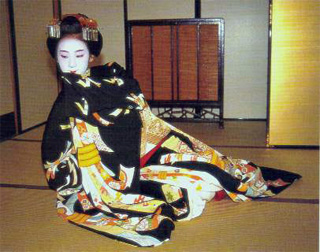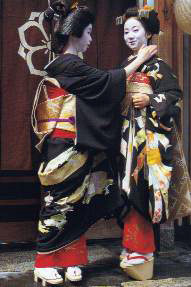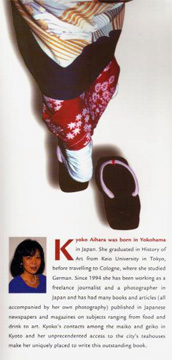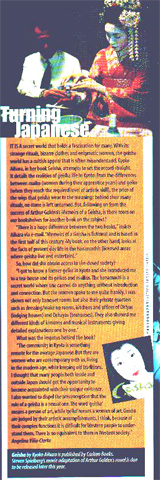published by Carlton Books Limited (UK) : ISBN 1-85868-937-6 / English
published by Tuttle / English : ISBN 4-8053-0611-4
published by New Holland / English
published by DEE-SIGN / Hungarian : ISBN 963 00 3743 2
published by Soline / French : ISBN 2-87677-431-3
 |
 |
 |
 |
初版・英語版
ハードカバー
(出版社:
Carlton Books UK) |
英語版
ハードカバー
(出版社:Tuttle) |
ハンガリー語版
ハードカバー
(出版社:
DEE-SIGN/ブダペスト) |
初版刊行のCarlton Books が
ペーパーバックが刊行 |
(上記の初版〜Carlton Books〜の後、海外の何社もの出版社/Tuttle, Soline, Dee-Sign, New Holland
などから、英語、フランス語、ハンガリー語で出版されています)
* 日本語版は無く、写真と英語の原稿を著者(相原恭子)がCarlton Books/London へ入稿。オリジナルは英語版。日本に暮らす日本人が海外の出版社からの依頼で外国語で本を執筆し、刊行した稀な例と言われている
・・・behind the crested curtains of the ancient teahouses of Japan, and, as a result, misconceptions have arisen about the roles of the female entertainers- popularly known as geisha - who work within them. It is with Japan's ancient capital, Kyoto, that these women are historically associated and where the traditional strictures of their training is still upheld today.
Here they are called
Maiko during their apprentice years, and
Geiko when they reach the required level of artistic skill.
 |
 |
This book 「Geisha」 describes every aspect of the often harsh lives of these remarkable women:
their elaborate dress, hair and make up, the ceremonies and rituals in
which they are involved their accomplishment in traditional artistic skills
and their relationships with men and the outside world.
The Maiko and Geiko of Kyoto inhabit a unique and curious role in Japanese culture. A century ago they were a frequent sight in the city, as were similar female entertainers in other cities, but today their existence is fragile and few women remain in these demanding professions.
|
| It takes many years for the women to hone and refine their artistic
and conversational skills so that they can expertly entertain men in the
traditional manner and participate at Japan's colourful seasonal festivals.
Only in Kyoto does this level of expertise and training still exist in
the community, ensuring that The Maiko and Geiko who still live and work here are truly guardians of Japan's cultural past. |
 |
A geiko is working on her computer. |
 |
Ordinarily a Maiko will apply her make up herself, but on this day a make-up artists is employed.
Three lines, rather than the usual two, are left umpainted on the back of her neck. |
 |
A maiko and her onesan (elder sister) came out of the ochaya on the day of the Maiko's omisedashi.
The new maiko puts on new okobo (clogs). They are going to visit the ochayas
and restaurants where banquets are held to exchange greetings. Her onesan
introduces the maiko as her "younger sister" and wishes Good
Luck. |
 |
A maiko's okobo (clogs). 10 centimetres high and made of paulownia wood. The colour of the okobo's thong varies according to her career: red for the initial period, changing to pink and later purple, etc.
|
 |
Accompanied by Kyoko Aihara's original photographs, her informative and
honest text provides a fascinating and detailed portrait of a distinctive
and intriguing aspect of Japanese society.
Kyoko Aihara was born in Yokohama in Japan.
She graduated in History of Art from Keio University in Tokyo before traveling
to Cologne, where she studied German. Since 1994 she has been working as
a freelance journalist and a photographer in Japan and has had many books
and articles (accompanied by her own photography) published in Japanese
newspapers and magazines on subjects tanging from travel, food, drink to
art. Kyoko's contacts among the Maiko and Geikoin Kyoto and her unprecedented
access to the city's teahouses make her uniquely placed to write this outstanding
book.
[High Light] (Inflight Magazine British Airways, May 2000) |
|
It is a secret world that holds a fascination for many.With its strange rituals, bizarre clothes and enigmatic women, the geisha world has a cultish appeal that is often misunderstood.
Kyoko Aihara, in her book Geisha, attempts to set the record straight.
It details the realities of geisha life in Kyoto: from the differences between maiko (women during their apprentice years) and geiko (when they reach the required level of artistic skill), the price of the wigs that geisha wear to the meanings behind their many rituals, no stone is left unturned. But, following on from the success of Arthur Golden's Memoirs of a Geisha, is there room on our bookshelves for another book on the subject?
"There is a huge difference between the two books", insists Aihara via e-mail. "Memoirs of a Geisha" is fictional and is based in the first half of this century. My book, on the other hand, looks at the facts of present day life in the hanamachis (licensed ares where geisha live and entertain)".
So, how did she obtain access to the closed society?
"I got to know a former geiko in Kyoto and she introduced me to a tea house and its geikos and maikos. The hanamachi is a secret world where one cannot do anything without introduction and connection. But the women spoke to me quite frankly. I was shown not only banquet rooms but also their private quarters such as dressing/make up rooms, kitchens and offices of Okiyas (lodging house)and Ochayas (teahouses). They also showed me different kinds of kimonos and musical instruments giving detailed explanations one by one."
What was the impetus gehind the book?
"The community in Kyoto is something remote for the average Japanese.
But they are women who are contemporary with us, living in the modern age,
while keeping old traditions. I thought that many people both inside and
outside Japan should get the opportunity to become acquainted with their
unique existence. I also wanted to dispel the preconception that the role
of a geisha is a sexal one. The word "geisha" means a person
of art, while "geiko" means a woman of art. Geisha are judged
by their artistic accomplishments. I think, because of their complex functions
it is difficult for Western people to understand them. There is no equivalent
to them in Western society. |

"Turning Japanese" |
* [Geisha] - A living tradition by Kyoko Aihara was published by Carlton Books.
* For Asia and Japan [The worls of the Geisha] by Kyoko Aihara was published by Tuttle.